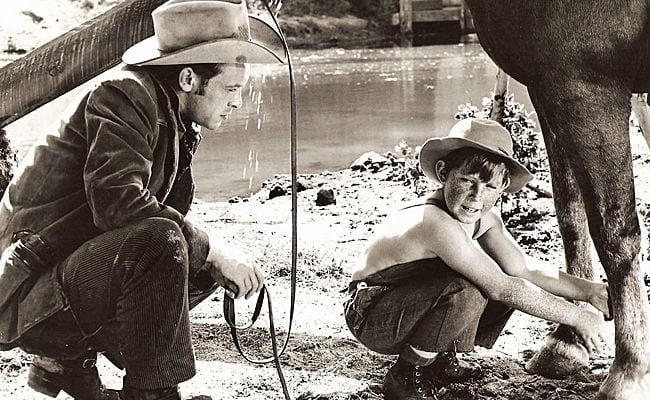
William Witney was a prolific American director identified with Republic serials, westerns, and other B-budgets. The Republic western Stranger at My Door, now available on DVD and blu-ray from Olive Films, is one of four titles that Quentin Tarantino has named as Witney’s finest films. Well, it’s very good.
It opens with a flurry of activity as a group of masked men on horseback rush out of town after chasing all the horses out of the livery and setting several buildings on fire. It’s a breathless, noisy, furious sequence full of gunshots and terror. The men, who have just robbed the bank, split the loot and head in different directions, but leader Clay Anderson (lanky and magnetic Skip Homeier) inveigles his way into a preacher’s house because his horse is lame.
The minister, Hollis Jarret (Macdonald Carey), realizes who Clay is but wants him to stay long enough to repent and save his soul under Jarret’s kindly and forbearing tutelage. Little freckled Dodie (Stephen Wootton), the minister’s son by his first wife, wants Clay to stay because of a burgeoning case of hero worship, though the boy doesn’t realize their guest is also his admired outlaw.
Clay wants to stay because he’s got a hankering for the minister’s new bride, Peg (Patricia Medina, fresh from the makeup trailer), and he thinks she’s more cut out for the likes of him than being stuck out here with a hardworking older man of God who’s building a church on his property. The scenes between Medina and Homeier are sexy and have real tension — more so than, say, the comparable scenes with the honorable cowpoke in Shane, more like the wonderful Rachel and the Stranger.
This set-up is simple and complex at the same time, and the often surprising script by Barry Shipman (who often worked with Witney) doesn’t settle for the obvious. This is melodrama, not realism, but the various factions and vacillations are well-balanced and thoughtful, even ambiguous in a way of which the characters are aware, and it makes me wonder about Shipman’s other prolific output for films and TV.
Minor detail: the scene that introduces Dodie is at a pond where he’s checking a watermelon in a tub or vat, and we realize that this is refrigeration. It’s a small point, but the sort that marks good writing and gently brings the era to life. I can’t help comparing with the opening detail in another western I saw right after, the Italian Day of Anger, where the put-upon hero is a kind of reverse milkman who trudges through town emptying buckets that apparently come from privies or outhouses, and which are put out front for him. Why? I couldn’t help wondering if there was truly such a service, because it seemed to be invented for the purpose of prominent thematic symbolizing rather than credibility.
Back to Witney’s film: There are complicating visits from the sheriff (Louis Jean Heydt), a neighbor (Slim Pickens), a black-clad circuit preacher (Malcolm Atterbury), and the local doc (Howard Wright), all of whom are sketched in quick distinctive strokes. Much business pivots on a beautiful, elegantly symbolic wild black stallion called Lucifer, whom Hollis vows to tame once the horse “learns there’s nothing to fear” (a repeated theme about faith in God). This horse is the star of an alarming, even harrowing setpiece that goes further than we expect, and it’s about as disturbing a use of a horse as any scene this side of Gore Verbinski’s The Ring. You’ll wonder how the horse was directed; Witney discussed it in his memoir and in a Vimeo clip.
There’s also a complicated chase at the end, in keeping with the title of Witney’s memoir, In a Door, Into a Fight, Out a Door, Into a Chase. But it’s not only about the skillful direction of action, though that’s here. The camera is continually as elegant as Lucifer with its confident dollies and glides, which are especially notable during outdoor scenes with Homeier and Medina as they feel the pull of each other’s gravity. Scene after scene is excellent, with one highlight being the blustery night sequence when Peg holds a rifle on Lucifer and Clay.
With all this visual simplicity and emotional complexity, with the continual tension building to an explosion among likeable characters, we arrive at an ending that, as one character observes, is something of a miracle — at least as far as balancing Hollywood’s corny incredulities against the intense and electric. Again, the visual sense matters as much as the script, and the final scenes manage to be grand and understated at the same time.
This print is excellent and clean, showing off Bud Thackery’s photography. There are no extras. This isn’t some towering milestone of the genre; instead, it’s something harder to pull off: a quietly intelligent, handsomely made, satisfying B-western that puts you through a very pleasant wringer for 85 minutes.


![Call for Papers: All Things Reconsidered [MUSIC] May-August 2024](https://www.popmatters.com/wp-content/uploads/2024/04/all-things-reconsidered-call-music-may-2024-720x380.jpg)



